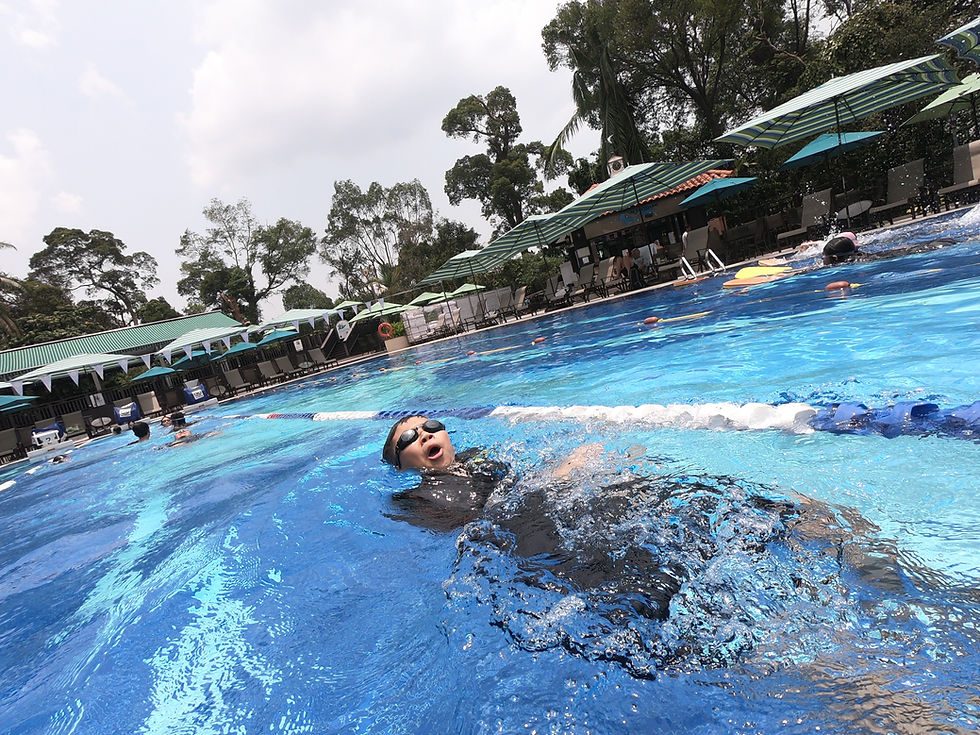How to Smoothen Your Backstroke Transition Turns
- SG Sink Or Swim

- Sep 4
- 3 min read

Backstroke transition turns are a critical skill for swimmers aiming to maximize efficiency in races, especially in Individual Medley (IM) or backstroke events. Unlike freestyle flip turns or breaststroke pullouts, backstroke turns require precise timing, body awareness, and smooth execution to maintain momentum. A well-executed turn can shave valuable seconds off your time, while a poorly timed one can disrupt rhythm and cause disqualification.
If you’re looking to smoothen your backstroke transition turns, this guide covers technique, drills, and training strategies to improve your performance.
🏊♂️ Why Backstroke Transition Turns Matter
Efficiency: A seamless turn minimizes drag and maintains speed.
Momentum: Proper push-offs and streamlines carry you further underwater.
Race advantage: Small improvements in turns can make a big difference in overall times.
Legal execution: Correct rotation and wall contact help you avoid disqualification in competitions.
🔑 Key Elements of a Smooth Backstroke Turn
Stroke Count Awareness - Learn how many strokes it takes from the backstroke flags (5 meters from the wall) to reach the wall. Consistency ensures you don’t over-rotate or crash into the wall.
Body Rotation - Swimmers must rotate from backstroke onto their front before initiating the flip. The rotation should be quick, controlled, and within one arm pull, per regulations.
Fast Flip - Like freestyle, the flip should be compact. Tuck your knees in, stay tight, and plant your feet firmly on the wall.
Streamlined Push-Off - Push off with both feet, keep your arms in a tight streamline, and use the underwater dolphin kick effectively before surfacing.
Timing the Breath - Avoid breathing right before the turn — this helps keep your body tight and your head in the proper position.
🏋️ Drills to Improve Backstroke Transition Turns
1. Stroke Count Drill
Swim backstroke from the flags to the wall.
Count your strokes and repeat several times to build consistency.
Adjust stroke length until you can always reach the wall perfectly.
2. Rotation Drill
From mid-pool, swim backstroke and practice rotating onto your stomach at the flags.
Focus on quick, smooth rotation without losing momentum.
Add a dolphin kick after rotation to simulate the push-off.
3. Flip Turn Isolations
Swim freestyle to the wall and practice only the flip portion of the turn.
Once confident, add the rotation from backstroke into the flip.
Keep the motion compact to reduce wasted time.
4. Streamline Kick-Offs
Push off the wall in streamline and practice underwater dolphin kicks.
Focus on staying tight and breaking the surface smoothly.
Try holding the streamline longer each rep to build power.
5. Full Transition Repeats
Swim backstroke from the flags into the full transition turn.
Emphasize rhythm: stroke count → rotation → flip → streamline.
Video analysis can help you spot inefficiencies.
📋 Tips for a Smooth Turn
✅ Practice turns during warm-up and main sets — don’t save them for race day.
✅ Stay relaxed — rushing leads to sloppy execution.
✅ Train underwater kicks — strong dolphin kicks give you an edge.
✅ Drill under fatigue — practice turns when tired to simulate race conditions.
✅ Get feedback — coaches or underwater video can highlight errors you may not feel.
🏁 Conclusion
Backstroke transition turns are more than just a way to change direction — they’re an opportunity to gain speed, efficiency, and competitive advantage. By focusing on stroke count, body rotation, flip mechanics, and streamlined push-offs, you can significantly improve your performance. Adding targeted drills and consistent practice into your training will make your backstroke turns smoother, faster, and race-ready.
Master the turn, and you’ll master one of the most overlooked aspects of backstroke success.





Comments